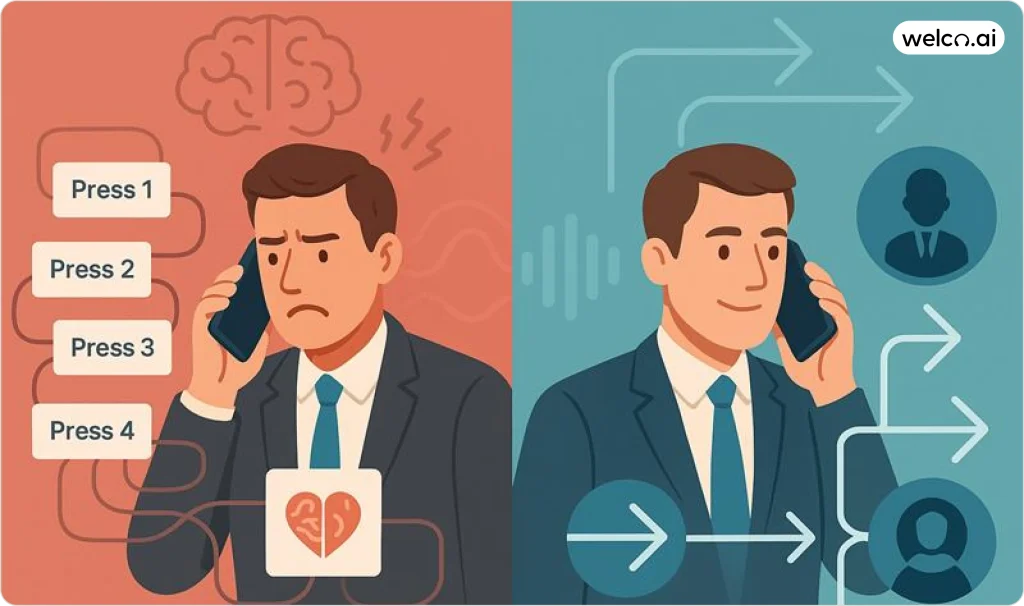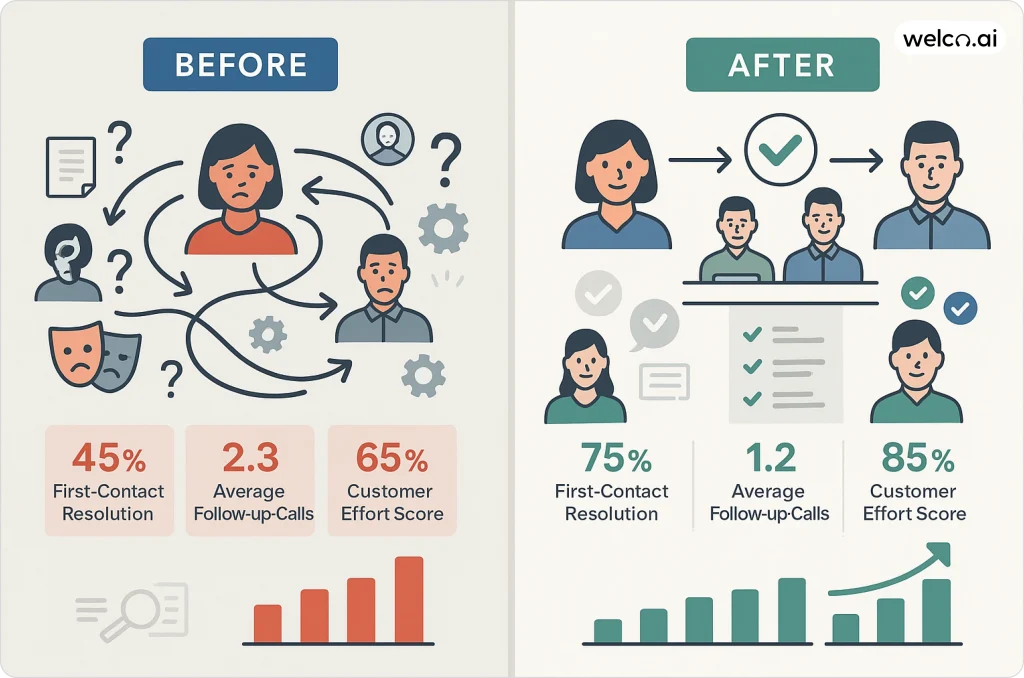Last Tuesday, I watched a potential client call our main number while sitting in our conference room. She hung up after 90 seconds, visibly frustrated. Later, she told me she’d already decided to go with a competitor before ever speaking to a human. That 90-second phone call cost us more than most people’s annual salary.
This happens thousands of times daily across businesses worldwide. The companies that understand the psychology behind these moments are quietly stealing customers from those that don’t. For businesses ready to take action, understanding how to build first impressions that win customers in 100 milliseconds becomes the logical next step after grasping these fundamental psychological principles.

The Real Cost of Psychological Friction
Here’s what most businesses don’t realize: your phone system isn’t just routing calls—it’s actively shaping how customers feel about your entire brand.
Research from the Harvard Business Review found that 96% of customers become disloyal after high-effort interactions. When someone calls your business, they’re not just seeking information—they’re forming judgments about your competence, reliability, and whether you actually care about solving their problems.
Every unnecessary menu option, each confusing transfer, and those dreaded “please hold” messages are small moments of giving up. By the time customers reach a human, they’ve often already emotionally checked out.
Why Your Brain Hates Phone Menus
The problem isn’t technological—it’s neurological. Human working memory can effectively process 3-5 options simultaneously. When your phone system presents 8 menu choices, you’re essentially asking customers to juggle more information than their brains can handle comfortably.
This creates what psychologists call “mental overwhelm”—a state where decision-making becomes progressively worse as mental fatigue increases. You know when you call a business and immediately think “please don’t make me listen to 10 menu options”? That’s your brain protecting itself from overload. It’s why customers often press random numbers or hang up entirely rather than listening to your carefully crafted menu options.
The “Repetition Rage” Factor
Here’s a number that shocked me: 33% of callers cite having to repeat information as their primary frustration. Each time a customer explains their problem to a new person, you’re not just wasting their time—you’re sending a clear signal that your systems don’t communicate and their previous effort was worthless.
It’s like asking someone to tell you their life story, then immediately forgetting everything they said. That feeling of wasted effort? It’s actually worse than never being helped at all.
The Three Pillars of Trust-Building Through Voice
After analyzing hundreds of customer service interactions, three psychological principles consistently separate businesses that customers love from those they abandon:

1. Competence Signaling
Your system needs to demonstrate immediately that it can actually solve problems, not just shuffle them around. This means:
- Providing realistic wait times (uncertainty amplifies anxiety)
- Offering specific next steps, not vague promises
- Connecting customers to the right person on the first attempt
2. Transparency Over Perfection
Customers trust honest limitations more than false capabilities. If your AI can’t handle complex billing disputes, say so upfront and route accordingly. This builds confidence that you’re being honest about what your system can actually do.
3. Emotional Acknowledgment
The most overlooked element: making customers feel heard rather than handled. Simple phrases like “I understand this is frustrating” or “Let me make sure I connect you with someone who can resolve this completely” can dramatically shift how the call makes people feel.
When Cultural Differences Can Kill Your Customer Experience
If you serve diverse customers, your routing approach might be accidentally alienating entire demographics. We learned this the hard way when our “friendly” AI assistant kept interrupting Japanese clients—something that felt helpful to Americans but incredibly rude to them.
Turns out, what Americans see as collaborative assistance, many Asian cultures experience as presumptuous interruption. The same AI behavior that makes US customers feel supported can make international customers feel disrespected.
- Individualistic cultures (US, Western Europe) prefer AI interactions that feel collaborative—like working with a knowledgeable partner
- Collectivistic cultures (many Asian countries) prefer more deferential interactions—respectful assistance that doesn’t feel presumptuous
These aren’t minor preferences. They’re deeply ingrained cultural expectations that influence trust formation at a gut level. For businesses serving diverse customer bases, implementing comprehensive multilingual AI capabilities can significantly improve customer satisfaction across all demographics.
A Real Implementation Story
The practice manager at a mid-sized healthcare clinic in Atlanta, Janet, told me she’d started dreading Monday mornings because that’s when the weekend’s worth of angry voicemails would pile up. “Patients were literally saying they’d rather drive 30 minutes to another clinic than deal with our phone system again.”
Janet told me the worst part wasn’t even the complaints—it was watching elderly patients get visibly frustrated trying to navigate the system during their already stressful medical visits.
Their phone system required 4 transfers on average to schedule a simple appointment, and patient complaints were mounting.
Here’s what they changed:
Week 1: Audited their current system by recording 50 random calls and mapping emotional journey points
Week 2: Redesigned routing to eliminate unnecessary decision points
Week 3: Implemented language that considers how people think (“I can help you schedule that appointment right now” vs. “Press 3 for scheduling”)
When we first tried this approach, we actually made things worse for two weeks—turns out our new system was too conversational and confused older patients who expected traditional menu structures.
Results after 8 weeks:
- 60% reduction in call abandonment
- 40% fewer patient complaints about phone experience
- 25% increase in same-day appointment bookings
- Staff reported significantly less stressed patients when calls did reach them
Janet noted: “Patients started commenting on how much easier it was to reach us. We realized our phone system was our first clinical impression.”

Practical Steps You Can Implement This Week
The 3-Option Rule
Audit your current phone menu. If you have more than 3-5 options at any level, you’re cognitively overloading callers. Consolidate related options or show choices gradually based on initial selection.
Ever call a business and by option 7 you’ve completely forgotten what option 2 was? That’s mental overwhelm in action. This might sound obvious, but I’m still surprised by how many businesses have 8+ menu options and wonder why customers hang up.
The Emotional State Check
Train your team to recognize and adapt to different caller emotional states:
- Urgent/Panicked: Immediate triage, no small talk
- Confused: Patient explanation with confirmation checks
- Frustrated: Acknowledgment first, then solution-focused routing
The “Escape Hatch” Strategy
Always provide a clear path for customers who don’t fit your menu options. “If none of these options fit your needs, press 0 to speak with someone who can help” prevents the psychological trap of feeling stuck.
We’ve all been that person frantically pressing ‘0’ hoping to reach a human, right?
Measuring What Actually Matters
Traditional metrics like “average handle time” often work against psychological comfort. Instead, track:
- Completion rate: Percentage of callers who reach their intended destination
- Transfer frequency: How often customers get passed between departments
- Emotional journey: Are customers more or less frustrated after your routing system?
- First-contact resolution: Problems solved without callbacks or additional interactions
The Generational Divide
Your routing strategy needs to account for dramatically different expectations:
If your customers grew up with smartphones, they expect your phone system to be as intuitive as ordering an Uber. If they remember rotary phones, they want clear structure and human voices.
Here’s what I think most people miss: the solution isn’t separate systems—it’s adaptive routing that recognizes and responds to different interaction preferences. Ever notice how you start getting anxious the moment you hear “please listen carefully as our menu options have changed”? That’s universal across generations.
Implementation Roadmap
Month 1: The Psychology Audit
- Record 20-30 customer calls across different times and scenarios
- Map the emotional journey: Where do customers get confused, frustrated, or give up?
- Count decision points and identify unnecessary complexity
- Survey recent callers about their experience
Month 2: Redesign and Test
- Simplify menu structures using the 3-option rule
- Rewrite prompts using conversational language
- Create clear escalation paths for frustrated customers
- A/B test new approaches against current system
Month 3: Optimization
- Analyze results using both efficiency and emotional metrics
- Train staff on interaction techniques that consider how people think
- Refine routing based on real customer feedback
- Document successful approaches for scaling
For organizations ready to implement these psychological principles with advanced technology, learning 24/7 customer service optimization strategies can help transform these concepts into comprehensive business solutions that work around the clock.
Beyond Basic Routing: Advanced Psychological Strategies
Voice Psychology: Research shows that slightly slower speech (10-15% below normal pace) improves comprehension without seeming condescending⁴. Natural pauses build trust and give customers time to process options.
Emotion Detection: Modern AI systems can identify emotional states with approximately 70% accuracy—actually exceeding average human emotion recognition. This enables dynamic routing based on caller emotional context. For businesses dealing with particularly sensitive situations, understanding how to manage complex customer interactions becomes essential for maintaining service quality when emotions run high.
Decision Fatigue Prevention: Implement showing options gradually and detection systems that simplify menus when customers show signs of decision overwhelm.
The Bottom Line
Your phone system is either building trust or destroying it—there’s rarely a neutral middle ground. The businesses winning in customer experience aren’t necessarily spending more on technology; they’re applying psychological principles to create interactions that feel effortless and human.
The difference between a customer who hangs up frustrated and one who becomes a loyal advocate often comes down to those first 60 seconds of their phone experience. Make them count.
For businesses ready to transform their phone systems from frustration points into competitive advantages, understanding how to develop a consistent voice brand identity ensures that psychological principles align with your overall brand strategy, creating cohesive customer experiences that build trust and drive results.
Frequently Asked Questions
How do I know if my phone system is causing psychological stress without directly asking customers?
Look for these telltale signs: high call abandonment rates (over 20%), frequent complaints about “getting the runaround,” and customers who sound frustrated by the time they reach a human. We also track what I call “option fatigue indicators”—listen to recordings and count how many times customers say “umm” or pause before making menu selections. If you hear a lot of hesitation, your menu is probably overwhelming them.
What if my business legitimately needs more than 5 menu options because we offer many different services?
This is the most common pushback I get, and I understand why. The solution isn’t fewer services—it’s smarter grouping. Instead of listing 12 different departments, create 3-4 logical categories first. For example, “New customers and sales,” “Existing customer support,” and “Billing and payments.” Then use progressive disclosure to show relevant sub-options. Think of it like a well-organized website navigation rather than a massive dropdown menu.
Won’t implementing these psychological principles make our system slower and less efficient?
Actually, the opposite happens. When customers reach the right person on the first try, overall call times decrease dramatically. Janet’s healthcare practice saw their average call resolution time drop by 35% because patients weren’t getting bounced between departments. The key insight: efficiency isn’t about speed—it’s about effectiveness. A 2-minute call that solves the problem beats three 5-minute calls that don’t.
How can I measure the psychological impact of our phone system changes beyond traditional metrics?
Start with post-call surveys asking one simple question: “How did our phone system make you feel?” Track the sentiment over time. We also listen for emotional language in call recordings—words like “finally,” “thank goodness,” or “at last” indicate relief, while sighs, repetition of information, or asking “can I just speak to a person?” signal frustration. Customer callbacks within 24 hours are another strong indicator that the psychological experience failed, even if the technical issue was “resolved.”
How can AI systems prevent decision fatigue in complex routing scenarios?
Decision fatigue is like mental exhaustion—the more choices customers face, the worse their decisions become. Our approach includes fatigue-detection algorithms that recognize when customers are becoming overwhelmed, showing options gradually instead of all at once, and automatic menu simplification when complexity increases beyond optimal levels. For businesses implementing these advanced features, developing strategic journey mapping frameworks ensures that psychological principles work harmoniously with technology capabilities.
How accurate is emotion detection in modern AI systems?
Current emotion detection technology has made remarkable strides: real-time emotion detection achieves approximately 70% accuracy, actually exceeding human emotion recognition accuracy (60%), and enables dynamic routing based on caller emotional states. This improves resolution rates by 20-35% when distressed customers are matched with empathetic agents. Organizations looking to maximize these capabilities should also consider how personalized automated customer interactions can enhance emotional intelligence with individual customer preferences and communication styles.
